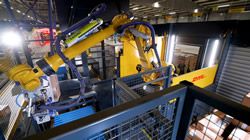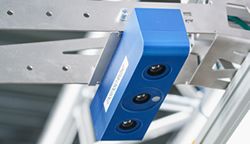Three eras of machine learning - A new paradigm
Simple rule-based algorithms have been used in the visual inspection market for many years, but as their limits have become more apparent, the need for more sophisticated software has grown.
Revolutionizing Machining Operations with Artificial Intelligence
The synergy between AI and CNC machining is set to reshape the future of manufacturing. Embracing these innovations will empower industries to achieve new levels of excellence, driving growth and success in an increasingly complex market.
Pallet by pallet - Intelligent robotic vision system destacks up to 800 objects per hour
One of the locations where RODE adds value is for DHL eCommerce in Rotterdam. In this machine, two Ensenso 3D cameras from IDS Imaging Development Systems GmbH are implemented to provide the required image data.
The Core of Optimizing Robotic Performance: Sensors in Warehousing
Without any external input to guide its actions or decisions, a robot would behave like a machine, performing tasks without adaptation or autonomy. Serving as the critical link between the robot and its environment, sensors enable the robot to perceive and interpret.
Inspecting Miniaturization: How 2D Laser Profilers Handle Tiny Electronic Components
The miniature size of modern electronic components makes placement, mounting, soldering, and testing of said components rather difficult. Given their size and the overall component density on the PCB, visual inspection is nearly impossible.
Why e-con systems' latest 5MP Global Shutter camera - e-CAM56_CUOAGX is ideal for factory automation
Embedded vision has transformed factory automation - thanks to advances in sensor technology, processing power, and AI. Discover the key features of e-CAM56_CUOAGX, e-con Systems' latest camera and see why it's perfect for factory automation.
How Ethernet Cameras Are Making a Comeback with New, Powerful Features
In this blog, you'll get expert insights about the role of Ethernet cameras in embedded vision, their challenges, and the exciting features that continue to make PoE technology extremely valuable.
The Evolution of Additive Manufacturing: How Automation Redefines Post-Processing Standards
In 2024, post processing metal parts is still a bottleneck in the AM process chain because it is still very often a manual, labor-intensive, messy (filthy, actually) and sometimes risky task.
The secret lives of manufacturing defects - How defects pass through the system undetected
Here Zohar Kantor, chief revenue officer at quality inspection pioneer QualiSense, traces how defects enter the manufacturing process and avoid detection.
Why Automated Optical Inspection Is a Winner in PCB Quality Control
Excelling in PCB quality control is a meaningful way to maintain competitiveness despite these conditions. Many decision-makers have increasingly invested in automated optical inspection (AOI) at their facilities. This approach leads to numerous benefits.
Why training with few good images is fake news
As recently as five years ago, the only way to teach a machine vision system what a good product looked like was to laboriously show it every possible fault, mark and annotate the errors and catalogue them.
Enhancing Safety Standards in Manufacturing Environments with Vision AI
This piece delves into Vision AI's pivotal role in reshaping safety paradigms in manufacturing. But before we dive in, let's first decode the workings of Vision AI.
Augmented Intelligence in Machine Vision - is Furthering Human Intelligence More Effective Than Replacing It?
Augmented intelligence is similar to artificial intelligence in that it uses machine learning algorithms to enhance defect detection. However, instead of aiming to replace human intelligence, augmented intelligence aims to build upon it.
Understanding the Role of Machine Vision in Industry 4.0
Today it is being applied to diverse areas such as monitoring processes for predictive maintenance, and robotic guidance that makes it possible for robots to safely work with and respond to human interactions.
Using Infrared to Ensure Package Seal Integrity
Using infrared inspection as part of a quality control program allows for inspecting all package seals in the production line. Companies can ensure package seal integrity, promote product quality, and elevate customer satisfaction by implementing package line inspection.
Records 1 to 15 of 63
Featured Product

Using AI to Collect & Leverage Data
Data is the foundation of Industry 4.0. While skilled workers will always be essential, data is reshaping the manufacturing landscape, enabling automation of repetitive tasks, empowering smarter decision-making with AI assistance, and reducing defects and downtime. This shift allows small and medium-sized manufacturers (SMMs) to compete more effectively on quality, speed, and cost. While AI and machine learning systems typically require around two years to collect enough data to reach their full potential, manufacturers can start seeing benefits almost immediately with basic analysis tools and dashboards. Our MEP National NetworkTM expert explains how in this Manufacturing Tomorrow article.










.jpg)




